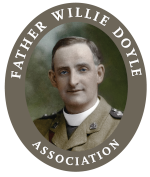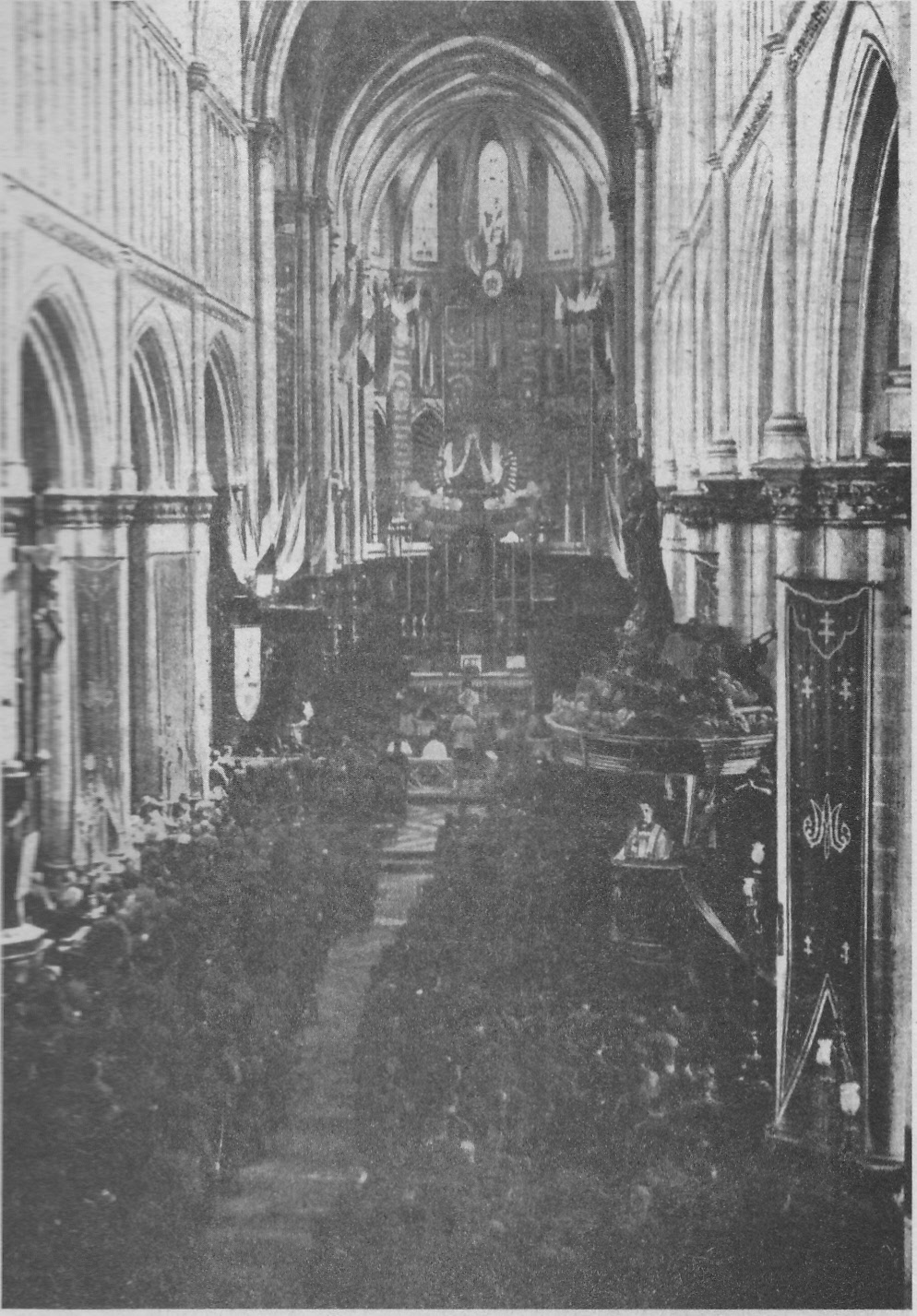Fr Willie gave his last homily 104 years ago today. Here is Alfred O’Rahilly’s account of this last sermon, complete with valuable first hand testimony from the famous Fr Frank Browne SJ:
The 48th Brigade was at rest or rather down for a rifle shooting course near St. Omer. The 2nd and 8th Dublins were in and around the little village of St. Martin au Laert about a mile and a half from St. Omer, the 9th Dublins about a mile distant in a country camp, and the R. I. Rifles a little further away. The new Bishop of Arras, Boulogne and St. Omer, Mgr. Julien, was to make his formal entry into Arras on Saturday, 20th July, and to be present next day at the conclusion of the Novena to our Lady of Miracles. Through the instrumentality of Fr. Browne, with the ready compliance of General Hickie, it was arranged that there should be a church parade in honour of the Bishop on Sunday, 15th. About 2,500 men came down. Fr. Browne said Mass and Fr. Doyle preached. The ceremony, which was most impressive and successful, has fortunately been described in a letter of Fr. Browne, which we are allowed to reproduce:
“I arrived at the Cathedral about 11o’clock (says Fr. Browne), and was in despair to find that the Pontifical High Mass was not yet finished. Our people are so punctual and the French so regardless of time-tables that I was sure there would be confusion and delay when our 2,000 Catholics would begin to arrive. But it was not to be. Quietly and wonderfully quickly the Mass ended, and the people went out to watch the Bishop go back in procession to his house close by. I was relieved to see that neither he nor any of the priests unvested. Then Fr. Doyle and I had to try to clear away the hundred or so people who remained and the other hundred or so people who came wandering in for the last Mass which for the day was to be ours. “Make room, please, for the soldiers who are coming” I went round saying to everyone. They moved from the great aisle and got into the side-chapels, leaving the transepts and aisles free. Many refused to do this when with pious exaggeration I said, About 3,000 Irish soldiers are just coming. And lo ! they were coming. Through all the various doors they came, the 9th Dubs, marching in by the great western door, the 8th Dubs, through the beautiful southern door, through which St. Louis was the first to pass just 700 years ago, the 2nd Dubs, coming into the northern aisle and making their way up to the northern transept. Rank after rank the men poured in until the vast nave was one solid mass of khaki with the red caps of General Hickie and his staff and the Brigadiers in front. Then up the long nave at a quick clanking march came the Guard of Honour. Every button of its men, every badge, shone and shone again; their belts were scrubbed till not even the strictest inspection could reveal the slightest stain, and their fixed bayonets only wanted the sun to show how they could flash. Up they came, and with magnificent precision took their places on either side of the altar. I was just leaving the sacristy to begin Mass when I saw the Bishop’s procession arriving. He had promised to come only after the sermon, but here he was at the beginning of the ceremony, making everything complete. Of course, I saw nothing, being engaged in saying Mass, but those who did said it was a wonderful sight. The beautiful altar, standing at the crossing of the transepts and backed by the long arches of the apse and choir, was for the feast surrounded by a lofty throne bearing the statue of our Lady of Miracles. The sides were banked up high with palms; then the Guard of Honour standing rigidly in two lines on either side; lastly the Bishop in his beautiful purple robes on his throne. From the pulpit Fr. Doyle directed the singing of the hymns, and then, after the Gospel, he preached. I knew he could preach, but I had hardly expected that anyone could speak as he spoke then. First of all he referred to the Bishop’s coming, and very, very tactfully spoke of the terrible circumstances of the time. Next he went on to speak of our Lady and the Shrine to which we had come. Gradually the story was unfolded; he spoke wonderfully of the coming of the Old Irish Brigade in their wanderings over the Low Countries. It was here that he touched daringly, but ever so cleverly, on Ireland’s part in the war. Fighting for Ireland and not fighting for Ireland, or rather fighting for Ireland through another. Then he passed on to Daniel O Connell’s time as a schoolboy at St. Omer and his visit to the Shrine. It certainly was very eloquent. Everyone spoke most highly of it afterwards, the men particularly, they were delighted.
“After the sermon Mass went on. At the Sanctus I heard the subdued order, Guard of Honour, shun! There was a click as rifles and feet came to position together. Then as the Bishop came from his throne to kneel before the altar, twelve little boys in scarlet soutanes, with scarlet sashes over their lace surplices, appeared with lighted torches and knelt behind his Lordship. At the second bell came the command, Guard of Honour, slope rifles ! And then as I bent over the Host, I heard, Present arms! There was the quick click, click, click, and silence, till, as I genuflected, from the organ-gallery rang out the loud clear notes of the buglers sounding the General’s Salute.”
At the end of the Mass the Bishop in a neat little speech thanked the men for the great honour they had paid him. He was especially struck, he said, by the fact that most of them had marched a long way (some nearly ten kilometres) to attend, and he asked those of his flock who were present to learn a lesson from the grand spirit and deep faith of the Irish soldiers. The ceremony concluded by a march past, with bands playing, in front of the Episcopal Palace. The Bishop stood on the steps of his house, beaming as he replied to the eyes right of each company as it passed him.
This last sermon of Fr. Doyle will serve as a final proof if such be needed that the man, whose inner life has been portrayed in previous chapters, was no awkward recluse or unpractical pietist. He was full of lovable human qualities; especially conspicuous was his unselfish thoughtfulness which always seemed so natural, so intertwined with playful spontaneity, that one came to take it for granted. He had a wonderful influence over others and knew how to win the human heart because he had learnt the Master’s secret of drawing all to himself. He could, as we have just seen, preach persuasively when occasion demanded; but his real sermon was his own life. And from this pulpit he spoke alike to Protestants and Catholics. “For fifteen months,” writes Dr. C. Buchanan (8th Sept., 1917), ” Fr. Doyle and I worked together out here, generally sharing the same dug-outs and billets, so we became fast friends, I acting as medical officer to his first Battalion. Often I envied him his coolness and courage in the face of danger: for this alone his men would have loved him, but he had other sterling qualities, which we all recognised only too well. He was beloved and respected, not only by those of his own Faith, but equally by Protestants, to which denomination I belong. To illustrate this Poor Captain Eaton, before going into action last September, asked Fr. Doyle to do what was needful for him if anything happened to him, as he should feel happier if he had a friend to bury him. Capt. Eaton was one of many whom Fr. Doyle and I placed in their last resting place with a few simple prayers. For his broad-mindedness we loved him. He seldom if ever preached, but he set us a shining example of a Christian life.”
O’Rahilly makes the following remarkable point in a footnote in relation to Fr Willie’s kindness towards this same Dr Buchanan:
Once when Dr. Buchanan was unwell and there were no blankets to lie upon in the damp dug-out, Fr. Doyle lay flat, face downwards, on the ground, and made the doctor lie upon him.

